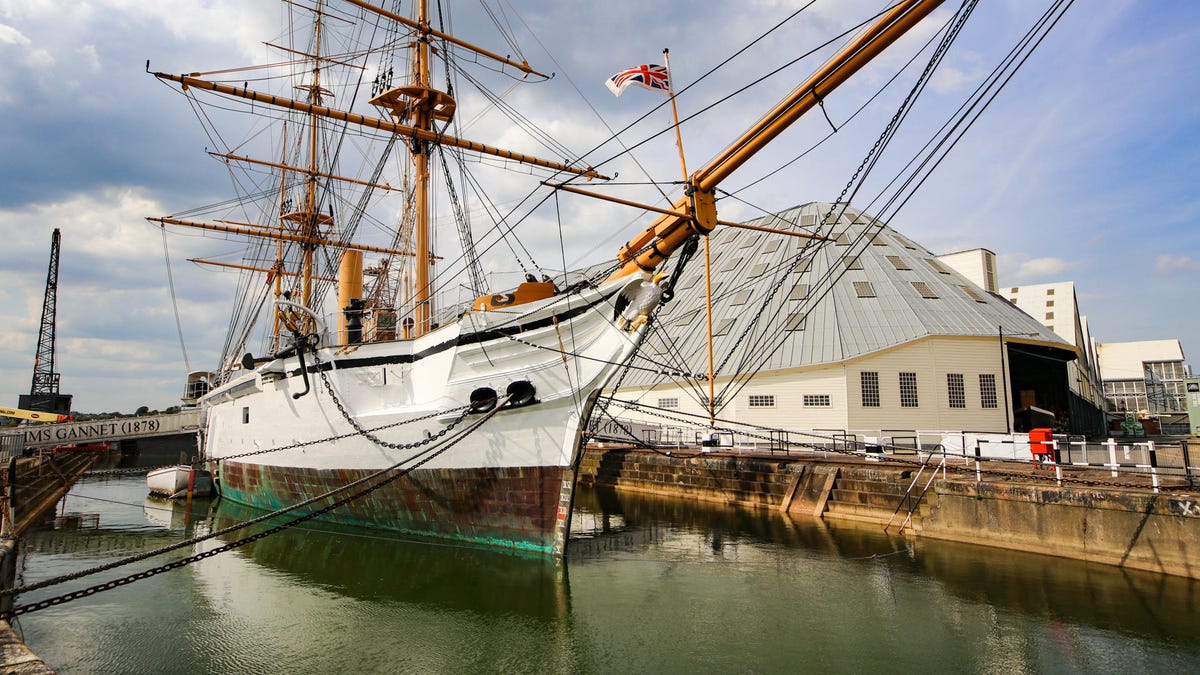 Why You Can Trust CNET
Why You Can Trust CNET From sails to subs: 400 years of shipbuilding at the Chatham Historic Dockyard
For four centuries, the Dockyard at Chatham built ships for the Royal Navy and her allies. Today it’s a massive museum, with ships from the age of steam, WWII and the Cold War. Here’s the full tour.

For over 400 years the Chatham Dockyard just outside London built boats for the British Navy and their allies. From sailing ships to submarines, Chatham built over 500 vessels. Today it's a naval museum with multiple ships, vehicles, and more, making it one of the best military museums in southeast England.
A journey that once would have taken many hours now takes less than one to arrive from London. The dockyards are only on a slightly smaller footprint than they were in their heyday. Multiple drydocks and covered slips, along with various beautiful Georgian and Victorian-era buildings, make it like stepping back in time. Its beauty is not lost on Hollywood, with movies and shows like Sherlock Holmes, The Crown, and Les Miserables all using it for a filming location.
What's in those drydocks is just as interesting, if not more so. The sloop HMS Gannet catches the eye first, and how could it not, with its towering masts. Adjacent is the low, black hulk of the Oberon-class submarine HMS Ocelot. Last in the row is the WWII-era C-class destroyer HMS Cavalier.
Those, and more fascinating things from Chatham, in the gallery below.
Check out 400 years of shipbuilding history at the Chatham Historic Dockyard
See all photosSteel and sails
It's hard to believe, but the Gannet and Cavalier are closer in time to each other than the Cavalier is to us now. Launched in 1878 and 1943 respectively, they represent the cutting-edge of naval design for their class and day.
The Gannet is what's called a "composite" design, with wood and steel. These days we'd probably call it a hybrid. There's clean, free energy up top, with sails capable of driving the ship up to 15 knots with a good wind. Down below was a two-cylinder steam engine, which powered a screw and topped out at 12.5 knots. Yep, sails were faster than an engine, which was the case for decades.
The Cavalier ran on steam too, but in this case 6-plus decades of technological advancement meant two steam turbines that helped propel the destroyer to a maximum speed of around 32 knots. So, two to three times the speed, plus significantly better armament. It was called the "fastest ship in the fleet."
Under the sea
The Oberon-class HM Submarine Ocelot was a cutting-edge design with a different goal: stealth. One of the quietest ships of her time, she was tasked with many clandestine missions that are still classified to this day.
We did a deep, ahem, dive of the Ocelot a few weeks ago, which you can check out in the gallery below and in Silence in the deep: A look inside the HMS Ocelot.
Ropery, tanks, and more
Three historic ships would be more than enough for most museums, but that's only part of what makes Chatham interesting. The ropery -- you guessed it, the place where they make rope, or line, for ships -- was the longest brick building in its day. Even now it's a longer open interior space than you've probably ever seen: over a 1,100 feet, or 340m. And amazingly, it's still in use today.
A Tiny Planet photo from the mezzanine floor of the No. 3 Covered Slip. From my Instagram.
The covered slipways are a sight in themselves. The gorgeous curved building you can see in the top photo, the No. 3 Covered Slip, is not new, despite its looks. It was built in 1838, and looks even cooler inside.
This building houses a collection of tanks and armored vehicles, while the adjacent building is home to the largest collection of lifeboats in the UK.
A day back in time
There is a lot to see at Chatham. I spent 5 hours and toward the end had to rush to make sure I got enough photo coverage for the gallery above, and I still missed things. It's a bit on the expensive side, £24 ($31.50/AU$42.50) for adults at the gate, but that gets you unlimited revisits for the rest of the year. Kids are way cheaper, though, so that makes it easier if you've got wee ones.
If you're headed to the Docks by train, take the bus from the station. The walk is a lot farther than it appears on Google Maps . The entrance shown is not pedestrians passable.
The Chatham Historic Dockyard is open February through early December, from 10 a.m. to between 4 and 6 p.m. depending on the time of year. Definitely worth a visit, or for now, check out the galleries above.
As well as covering audio and display tech, Geoff does photo tours of cool museums and locations around the world, including nuclear submarines, aircraft carriers, medieval castles, epic 10,000-mile road trips and more.
Also check out Budget Travel for Dummies, his travel book, and his bestselling sci-fi novel about city-size submarines. You can follow him on Instagram and YouTube.

